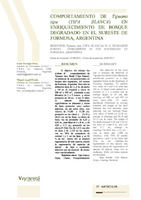Comportamiento de Tipuana tipu (tipa blanca) en enriquecimiento de bosque degradado en el sureste de Formosa, Argentina
Behavior Tipuana tipu (tipa blanca) in a degraded forest enrichment in the southeast of Formosa, Argentina
Abstract
El objetivo del trabajo fue evaluar el comportamiento de Tipuana tipu Benth (Tipa blanca), en prácticas de enriquecimientos en bosque alto degradado, del sureste de Formosa, Argentina. Para ello se utilizaron fajas de 4 y 8 m. de ancho y 100 m. de longitud; y claros de 400 m² y 900 m², plantadas a una distancia de 2 x 2 metros y altura promedio de 50 cm. A los 25 años, se detectó diferencias significativas en diámetro y altura de fuste promedio entre ambos métodos, no así entre ellos, con valores de 34,08 y 33,28 cm. promedio en los claros y 29,10 y 30,12 cm. en las fajas. La altura de fuste, fue en promedio de 6,20 y 6,04 m., para fajas de 4 y 8 m., y de 4,03 y 4.11 m., promedio en los claros. El IMA fue de 1,214 cm./año en fajas y de 1,328 en los claros, con un 70% de ejemplares de calidad 1 y 2 en las fajas, y un 50 % en los claros. No se observó regeneración de esta especie, siendo la regeneración de especies de interés de baja a moderada, mientras que las especies de escaso valor son abundantes. The objective of the work was to evaluate the behavior of Tipuana tipu Benth (Tipa Blanca) in enrichment practices in a high degraded forest, in the Southeast of Formosa, Argentina. To achieve this, strips of 4 and 8 m wide and 100 m. of length were planted at a distance of 2 x 2 meters and an average height of 50 cm; and clearings of 400 m² and 900 m² were used. After 25 years, significant differences in average diameter and height of the shaft between the two methods were detected, but not between them, with values of 34.08 and 33.28 cm. average in clearings and 29.10 and 30.12 cm. in strips. The height of the shaft averaged 6.20 and 6.04 for the strips of 4 and 8 m., and 4.03 and 4.11 m., average in clearings.The IMA was 1.214 cm. / year in strips and 1,328 on clearings, with 70% of quality specimens 1 and 2 in the strips, and 50% in the clearings. No regeneration of this species was observed, being the regeneration of species of interest from low to moderate, while low-value species are abundant.
URI
https://hdl.handle.net/20.500.12219/2661http://yvyrareta.com.ar/index.php/component/k2/item/54-comp-tipa-blanc
Collections
- Revista Yvyraretá [360]
The following license files are associated with this item:




